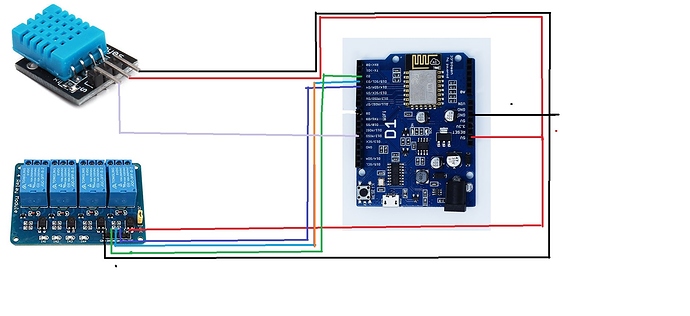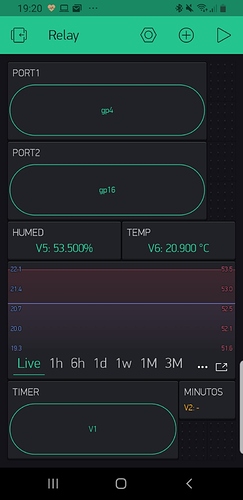Hello friends, I have made a new project that I found on a programmer’s YouTube (Csongor Varga) I have it working very well.
But my question is how can I make the timer relay work in second now works in minutes and I have 2 minutes.
but I would need only 30 seconds.
#define BLYNK_PRINT Serial
#include <ESP8266WiFi.h>
#include <BlynkSimpleEsp8266.h>
#include <DHT.h>
// You should get Auth Token in the Blynk App.
// Go to the Project Settings (nut icon).
char auth[] = "xxxxxxxxxxxxxxxxxxxxxxxxxxxxxxxxxxxxx";
// Your WiFi credentials.
// Set password to "" for open networks.
char ssid[] = "xxxxxxxx";
char pass[] = "xxxxxxxxxxxx";
int chargeState = LOW;
int chargeTime = 2; // charge times in minutes
int chargeCounter = 0; // counting down the charge time in seconds
#define DHTPIN 12 // Pin the DHT sensor is connected to
//#define DHTTYPE DHT11 // DHT 11
#define DHTTYPE DHT21 // DHT 21, AM2301
#define CHARGEPIN 5 // Pin for the charger door relay
#define GARAGEPIN 4 // Pin for the garage door relay
#define GATEPIN 16 // Pin for the gate relay
DHT dht(DHTPIN, DHTTYPE);
BlynkTimer sensor; // Timer object for the DHT sensor
BlynkTimer charger; // Timer object for the charger
// This function reads the DHT 11 sensor and saved the temparature and humdity reading to V5 and V6
void sendSensor()
{
float h = dht.readHumidity();
float t = dht.readTemperature(); // or dht.readTemperature(true) for Fahrenheit
if (isnan(h) || isnan(t)) {
Serial.println("Failed to read from DHT sensor!");
return;
}
// Please don't send more that 10 values per second.
Blynk.virtualWrite(V5, h);
Blynk.virtualWrite(V6, t);
}
// This function initiates, completed the charger relay, and counts down the charge time
void countCharger()
{
if (chargeState) {
// charger is running
chargeCounter--;
Blynk.virtualWrite(V2, chargeCounter/60+1); // Update the counter to V2 to display the remaining time in the app (divide by 60 to show minutes)
if (chargeCounter == 0) {
// Counter has reached zero, the charge time is up
Serial.println("Charging completed...");
chargeState = LOW; // Set the internal flag low
digitalWrite(CHARGEPIN, HIGH); // Turn off the relay
Blynk.virtualWrite(V1, LOW); // Turn off the button state in the app
Blynk.virtualWrite(V2, "-"); // Update the counter in the app to "-"
}
}
}
// This function gets called when the charger button is turned on/off in the app
BLYNK_WRITE(V1)
{
int pinValue = param.asInt(); // assigning incoming value from pin V1 to a variable
if (pinValue) {
// Charger was turned on in the app
Serial.println("Charger starting...");
chargeState = HIGH;
digitalWrite(CHARGEPIN, LOW); // Turn on the relay
chargeCounter = chargeTime * 60; // Set the internal counter value in second
Blynk.virtualWrite(V2, chargeCounter/60); // Update the remaining time in the app (divide by 60 to show minutes)
} else {
// Charger was turned off in the app
Serial.println("Charging stopped...");
chargeState = LOW;
digitalWrite(CHARGEPIN, HIGH); // Turn on the relay
Blynk.virtualWrite(V2, "-"); // Update the counter in the app to "-"
}
}
void setup()
{
// Debug console
Serial.begin(9600);
Serial.println("Booting up...");
Serial.println("Setting initial pin states");
// In the next few lines the initial states of the relay outputs are set
pinMode(GARAGEPIN, OUTPUT);
pinMode(GATEPIN, OUTPUT);
pinMode(CHARGEPIN, OUTPUT);
digitalWrite(GARAGEPIN, HIGH);
digitalWrite(GATEPIN, HIGH);
digitalWrite(CHARGEPIN, HIGH);
Blynk.begin(auth, ssid, pass);
// You can also specify server:
//Blynk.begin(auth, ssid, pass, "blynk-cloud.com", 8441);
//Blynk.begin(auth, ssid, pass, IPAddress(192,168,1,100), 8442);
dht.begin();
// Setup up the callback functions. DHT read every 2 seconds, charger countdown ever second.
sensor.setInterval(2000L, sendSensor);
charger.setInterval(1000L, countCharger);
}
void loop()
{
Blynk.run();
// You can inject your own code or combine it with other sketches.
// Check other examples on how to communicate with Blynk. Remember
// to avoid delay() function!
// Kick off the timers
sensor.run();
charger.run();
}```
